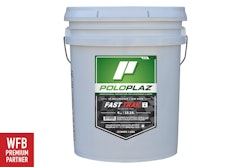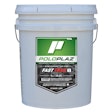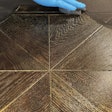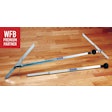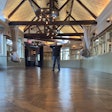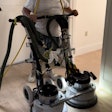Staining Exotics
Can I stain exotic floors?
Bob Gehl, president at Gehl Flooring Supply Inc. in Butler, Wis., answers:
Some people consider staining exotic wood floors an act of futility, or they believe it ruins the floor's natural beauty. However, there's nothing wrong with simply producing what the customer wants. Exotic floors can be stained in order to enrich and enhance their natural beauty. In addition, staining these floors can also create a more consistent color across the entire floor surface, lessen the impact of sun exposure, or create a unique floor unto itself.
To achieve a more consistent color across the floor or to lessen the dramatic change the sun can have on an exotic, start by picking a stain color that is closest to the darker boards in your particular exotic wood's color palette. When applying a penetrating stain on exotics with the industry's standard methods, more often than not the stain color will seem to always come up some shade of brown. There are a couple of ways to avoid this. The first is to water-pop the floor. This allows for more of the dyes/pigments to penetrate the dense grain of exotics. An upgrade to this process is the use of a two-part wood bleach. The chemical reaction of the bleach with the wood surface makes the wood cells that much more porous, so the wood accepts more stain penetration.
Lastly, if color manipulation is still difficult and browns are all you see, the use of a small amount of ebony with any mixture of colors allows the color to become more predominant. It sounds counter-intuitive, but it makes it possible to take a wood like cumaru (Brazilian teak) and stain it the color tones of American cherry. This process provides the ever-sought-after American cherry color tones with the unmatched durability of exotics, something many homeowners and designers wish to have.
Concrete Myths
I nailed down a solid oak floor over a plywood subfloor on top of a slab in a 40-year-old home. Now the floor is cupping. Aren't old slabs safe, especially when they have plywood over them?
Frank Kroupa, technical advisor for the NWFA, answers:
The most common call I get on the NWFA's technical hotline is about floors cupping over slabs, and one reason is there are so many myths about moisture and slabs. This case demonstrates two. Many people think that a slab over five years old is "dry." But concrete slabs are like a sponge, so no matter how old they are, if they are exposed to moisture, they'll absorb it. In fact, a drawback to old slabs is they may not have a membrane underneath them, or if they did, it may have degenerated.
Another myth is if you lay plywood over the slab, the floor is protected from moisture. But, of course, plywood isn't a moisture barrier. Here are some other concrete myths I hear all the time:
- slabs above the 10th floor are safe from vapor emission.
- a slab is safe from moisture if it's in the desert or has good drainage.
- slabs that had a curing agent used in them are safe.
- a skim layer of primer protects the floor from vapor emissions.
- a thin concrete slab in a crawlspace (often called a "rat slab") prevents moisture problems.
Slip-Slidin' Away
My customers are concerned about their floor being slippery. How do I know which finish to use?
Bill Jauernig, national sales manager at Poloplaz, answers:
For customers concerned about slippery floors, you'll need to check the finish's coefficient of friction. A good option would be to use a finish approved by the Maple Flooring Manufacturers Association for sports floors, since all MFMA-approved finishes are tested for friction. In the test, an 80-pound weight is applied through a strut to a leather shoe and placed on a panel with floor finish on it. The panel and shoe are moved horizontally. The distance the panel moves before slippage is measured to read static coefficient of friction. All oil-modified and water-based finishes must be tested every three years by the MFMA. On Jan. 6, the MFMA modified its standard: The coefficient of friction must now be between 0.5 and 0.7.
It may be counter-intuitive, but typically, satin and satin matte finishes are more slippery than gloss and semi-gloss finishes. This is due to the additional silica flattening agents in lower-sheen finishes. However, finish manufacturers can adjust the silica particle size to make the texture rougher.
When consumers are concerned that their floor is slippery after installation, many times the problem can be resolved by asking them about their cleaning procedures. Often, using the proper cleaning products and procedures takes care of the problem.














